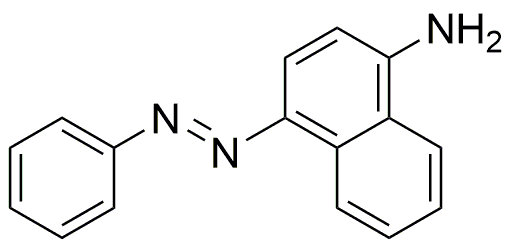4-Phenylazo-1-naphthylamine is widely utilized in research focused on:
- Dyes and Pigments: This compound serves as a key ingredient in the production of azo dyes, which are widely used in textiles and printing industries due to their vibrant colors and stability.
- Analytical Chemistry: It is employed as a reagent in various analytical techniques, such as spectrophotometry, to detect and quantify metal ions, enhancing the accuracy of environmental and industrial testing.
- Biological Research: The compound is used in studies involving cell staining and visualization, aiding researchers in observing cellular structures and processes under a microscope.
- Polymer Chemistry: It is incorporated into polymer formulations to improve color properties and UV stability, making it valuable in the production of plastics and coatings.
- Pharmaceutical Development: Researchers utilize this compound in the synthesis of pharmaceutical intermediates, contributing to the development of new drugs with improved efficacy and safety profiles.
General Information
Properties
Safety and Regulations
Applications
4-Phenylazo-1-naphthylamine is widely utilized in research focused on:
- Dyes and Pigments: This compound serves as a key ingredient in the production of azo dyes, which are widely used in textiles and printing industries due to their vibrant colors and stability.
- Analytical Chemistry: It is employed as a reagent in various analytical techniques, such as spectrophotometry, to detect and quantify metal ions, enhancing the accuracy of environmental and industrial testing.
- Biological Research: The compound is used in studies involving cell staining and visualization, aiding researchers in observing cellular structures and processes under a microscope.
- Polymer Chemistry: It is incorporated into polymer formulations to improve color properties and UV stability, making it valuable in the production of plastics and coatings.
- Pharmaceutical Development: Researchers utilize this compound in the synthesis of pharmaceutical intermediates, contributing to the development of new drugs with improved efficacy and safety profiles.
Documents
Safety Data Sheets (SDS)
The SDS provides comprehensive safety information on handling, storage, and disposal of the product.
Product Specification (PS)
The PS provides a comprehensive breakdown of the product’s properties, including chemical composition, physical state, purity, and storage requirements. It also details acceptable quality ranges and the product's intended applications.
Certificates of Analysis (COA)
Search for Certificates of Analysis (COA) by entering the products Lot Number. Lot and Batch Numbers can be found on a product’s label following the words ‘Lot’ or ‘Batch’.
*Catalog Number
*Lot Number
Certificates Of Origin (COO)
This COO confirms the country where the product was manufactured, and also details the materials and components used in it and whether it is derived from natural, synthetic, or other specific sources. This certificate may be required for customs, trade, and regulatory compliance.
*Catalog Number
*Lot Number
Safety Data Sheets (SDS)
The SDS provides comprehensive safety information on handling, storage, and disposal of the product.
DownloadProduct Specification (PS)
The PS provides a comprehensive breakdown of the product’s properties, including chemical composition, physical state, purity, and storage requirements. It also details acceptable quality ranges and the product's intended applications.
DownloadCertificates of Analysis (COA)
Search for Certificates of Analysis (COA) by entering the products Lot Number. Lot and Batch Numbers can be found on a product’s label following the words ‘Lot’ or ‘Batch’.
*Catalog Number
*Lot Number
Certificates Of Origin (COO)
This COO confirms the country where the product was manufactured, and also details the materials and components used in it and whether it is derived from natural, synthetic, or other specific sources. This certificate may be required for customs, trade, and regulatory compliance.


